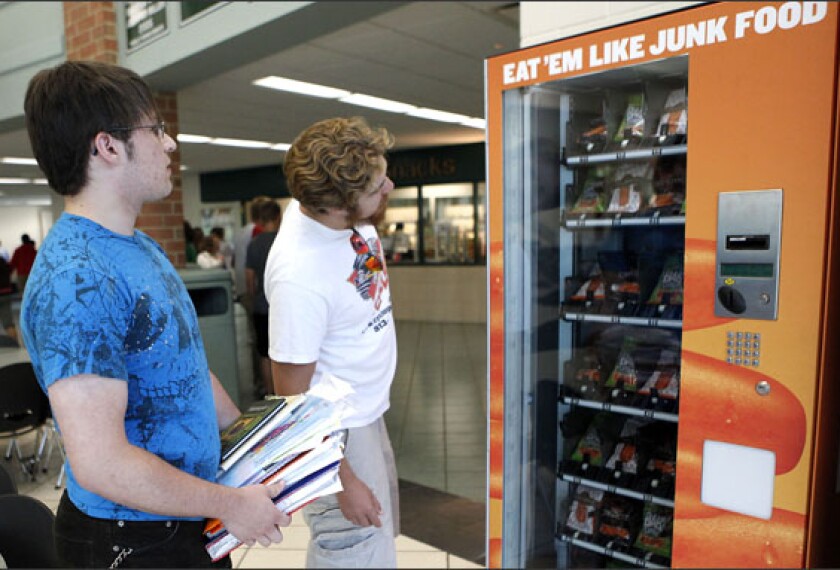Congress adjourned for the November elections without reauthorizing the federal law that controls the nation’s school meals program. But school nutrition and anti-hunger advocates say that delay could be a blessing in disguise.
Two competing versions of the Child Nutrition Act were introduced in the U.S. Senate and the House of Representatives, but the Senate version is further along: The proposed $4.5 billion , sponsored by Sen. Blanche Lincoln, D-Ark., was passed by the Senate in August. The House passed out of committee but has not been taken up for a vote by the full chamber. (“Bill Aims to Expand the Reach of Federal School Lunch Programs,” July 14, 2010.)
Some advocates, however, don’t want to pass the Senate measure unchanged because the 10-year bill would offset its proposed spending increases in part by cutting $2.2 billion from food stamps, known as the , or SNAP. Both the food-stamp and school-meals programs are run by the U.S. Department of Agriculture.
The debate over the child-nutrition bill comes as other efforts to provide students with healthy food while they are in school inch ahead. Advocates hope that the Department of Agriculture will act soon on guidelines for upgrading the nutritional content in school meals. And schools across the country are stepping up their own efforts to make healthy food “cool.”
As for SNAP, it received a funding boost in the 2009 federal economic-stimulus package, and Sen. Lincoln is quoted in an Aug. 5 article in Politico as arguing that the shift in funding from one nutrition program to another makes sense in a tight fiscal environment. The news publication reported that Ms. Lincoln said the money cut from the program would not have been spent until 2013, “so we’ve got time to recoup.”
The $8 billion House bill had not reached the point where offsets for its proposed spending increases had been identified.
Some Positives
But the move to shift funds from one program to another has sparked dismay.

“There’s major disappointment in the offset of the SNAP money,” said Cathy Schuchart, the vice president of child nutrition and policy for the , in Oxon Hill, Md. “We’re still holding out hope” for changes, she said.
Other parts of the Senate bill please the nutrition advocates. About $1.2 billion of the spending authorized under the legislation would go to addressing childhood hunger, while $3.2 billion would go to efforts to improve the quality of school meals.
One of the improvements that school nutrition advocates cheer: a 6-cents-per-meal increase in the reimbursement rate. Currently, states are reimbursed $2.72 for each free school lunch they provide, and that figure is adjusted each year for inflation. The reimbursement rates are lower for lunches sold at full or reduced price.
“The reimbursement rate has not been raised since the 1970s, so that’s a pretty big deal,” Ms. Schuchart said.
But all the positive changes should not come at the expense of low-income families, advocates said.
“This is not about the good parts of the bill,” he said. “It would be crucial to get a bill that does not plunder food stamps,” said James D. Weill, the president of the , an anti-hunger group in Washington.
The child-nutrition-reauthorization bill is not the only effort that school nutrition officials are expecting from Washington. A year ago, the Institute of Medicine released recommended school lunch , which the Agriculture Department is still reviewing. (“Report Calls for Upgrade to School Meal Programs,” Oct. 28, 2009.)
Ms. Schuchart said her organization has heard that Agriculture Department officials are hopeful that proposed regulations will be released by the end of the calendar year. They would then be open for a public-comment period before being released in their final form.
The recommendations say that the school meals program should increase the amount of vegetables and fruit that students are offered every day, and incorporate whole, instead of refined, grains into meals.
The recommendations also call for setting calorie limits on school lunches for the first time. Lunches should not be more than 650 calories for elementary school students, 700 calories for students in middle school, or 850 calories for high school students. Whole and 2 percent milk should be replaced by 1 percent and low-fat milk.
Ms. Schuchart said that many school meal programs and food vendors have been moving in the direction of the institute’s recommendations, by adding fruit and vegetable options and moving toward lower-sodium offerings.
Healthy Options
And many individual schools and districts around the country are engaging in activities to make nutritious food more appealing to students. For example, a baby-carrot vending machine was installed Sept. 17 in the 3,000-student Mason High School, in Mason, Ohio, a suburb of Cincinnati.
The vending machine was the work of a public relations effort launched on the part of Bolthouse Farms, a Bakersfield, Calif.-based grower that has created a series of tongue-in-cheek advertisements encouraging people to eat baby carrots “like junk food.” A similar vending machine was added at the same time at Fayetteville-Manlius High School in Syracuse, N.Y. Both will be in place for two months.
“It hadn’t been an hour after they filled the machines that we had students coming in and purchasing baby carrots,” Mason High Assistant Principal George Coates told the Middletown Journal newspaper in Ohio.
But the 10,400-student district has made several healthy-eating moves on its own, Darlene Hicks, the district’s supervisor of food-service management, said in an interview.
For example, the district has banished all unhealthy snacks. Vendors bring in a variety of fruits, such as kiwi, fresh sliced oranges, and mini bananas. Even a meal like nachos with melted cheese can include healthful ingredients, Ms. Hicks added.
“The ground corn is a whole grain, and the cheese is low-fat and fortified with protein,” she said.
Several districts, meanwhile, are using chefs in the community to get students interested in distinctive and healthful food.
Kim Minestra, the assistant food director for the 3,000-student Evanston Township High School District in Evanston, Ill., worked on a program that brought chefs into the school. Last month, chefs visited the high school for five days, introducing students to such foods as kale “chips” and pickled zucchini.
Ms. Minestra said that, for older students, it’s essential to talk them through new foods, not just leave a new dish out and hope they’ll try it.
“If our servers aren’t active with kids, it’ll just sit there,” she said.
Timothy Cipriano, the food-service director for the 20,800-student New Haven school district in Connecticut and a chef, said he sees a difference when he interacts with students while wearing his chef whites.
“When I walk in in my chef coat, I’m a rock star,” Mr. Cipriano said. “It’s like I’m a totally different person.” He plans to use that chef power this month when he brings community chefs to the district to get the students interested in healthy foods. Eighty percent of the students in the district qualify for free or reduced-price lunches.
Mr. Cipriano said he’s found that students will try an unfamiliar dish, if they have some hand in making it or promoting it to their classmates. For example, he created a butternut-squash-and-apple crisp that the students rebranded “squapple crisp”—and they liked it.






